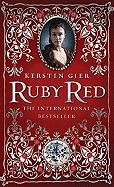
 This edge-of-your-seat adventure by German novelist Kerstin
Gier is no ordinary time travel book. To begin with, there are few rules: just don't
bring anything from the present back to the past, and dress for the period--otherwise
the "continuum" could be broken. Sixteen-year-old Gwyneth Shepherd
breaks both rules her first time out. That's not entirely her fault. She knows
that the "time travel gene" runs in her well-to-do London family. But
Charlotte Montrose, her cousin, was supposed to inherit the gene. Charlotte's
been training for this her whole life, with lessons in foreign languages and
how to dance the gavotte. Sir Isaac Newton predicted the birth dates of all the
time travelers in their family (which carries the gene for the female time
travelers) and in the de Villiers family (the male time travelers), and
Charlotte was born on the correct day. So was Gwyneth--it's just that her
mother, Grace Shepherd, covered it up. But why?
This edge-of-your-seat adventure by German novelist Kerstin
Gier is no ordinary time travel book. To begin with, there are few rules: just don't
bring anything from the present back to the past, and dress for the period--otherwise
the "continuum" could be broken. Sixteen-year-old Gwyneth Shepherd
breaks both rules her first time out. That's not entirely her fault. She knows
that the "time travel gene" runs in her well-to-do London family. But
Charlotte Montrose, her cousin, was supposed to inherit the gene. Charlotte's
been training for this her whole life, with lessons in foreign languages and
how to dance the gavotte. Sir Isaac Newton predicted the birth dates of all the
time travelers in their family (which carries the gene for the female time
travelers) and in the de Villiers family (the male time travelers), and
Charlotte was born on the correct day. So was Gwyneth--it's just that her
mother, Grace Shepherd, covered it up. But why?
A chronograph helps to control the time period in which the travelers will land, if they feed a sample of their blood into the machine. Once a sample from all 12 time travelers is placed into the chronograph, "the circle will be complete." But what happens upon its completion? Only the mysterious Count Saint-Germain, who invented the chronograph in the 18th century, knows for certain. Gwyneth's Aunt Lucy and Paul de Villiers stole the first chronograph, with blood samples from 10 of the travelers intact. The two samples missing belong to Gwyneth (aka Ruby Red) and Gideon de Villiers (the Diamond), Gwyneth's peer on the de Villiers side. The characters in Kerstin Gier's stellar story come fully to life, and veteran translator Anthea Bell (who translated Cornelia Funke's Inkheart books) preserves the book's abundant humor. Lesley Hay, Gwyneth's best friend, is the first person Gwyneth tells about her time-travel experience, and Lesley urges her to tell her mother. Luckily, Lesley, who worries for Gwyneth's safety, does her homework. She warns Gwyneth (whose pre-chronograph travel is unpredictable) that if she travels back to London's East End in 1888, "any man you meet is potentially dangerous" (Jack the Ripper was at large) and urges her to take refuge in St. Paul's Cathedral if she lands in the midst of the Blitz ("It did get hit once, but almost miraculously, it stayed standing," Lesley informs her).
There's something here for everyone: intrigue in the mystery of the Count's motives and why Lucy and Paul stole the chronograph before the circle could be completed; ghosts that only Gwyneth can see; 18th-century fencing matches; fashion to rival the costume department on a movie set. Gier has a field day with time travelers meeting up at various points in history, and several entries in the Annals of the Guardians (the keepers of the chronograph's secret) mention tips from the future (such as "buy shares in Apple, whatever that may be," penned in 1953; and Knotting Hill real estate will be "trendy," recorded in 1949). This first book in a planned trilogy comes to a pleasing conclusion while still leaving open the larger questions about the Count's motives, the results of the complete circle, and what Gwyneth and Gideon will bring to the overarching plot line.--Jennifer M. Brown

